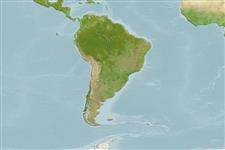Common names from other countries
Environment: milieu / climate zone / depth range / distribution range
Ecologie
; diepteverspreiding 0 - 15 m (Ref. 105490). Subtropical; 16°S - 41°S, 75°W - 70°W
Southeast Pacific: Peru and Chile.
Length at first maturity / Size / Gewicht / Leeftijd
Maturity: Lm ? range ? - ? cm
Occurs in the lowermost intertidal zone and immediate subtidal zone to 15 m on upper surfaces of rocks. In deep tide pools at low tide (Ref. 105490). Inhabits sublittoral rocky zone (Refs. 106267, 106270). Found on matrices of the tunicate Pyura praeputialis (Ref. 66198). Members of the Family Fissurellidae are herbivorous, grazing on algae (Ref. 104247).
Life cycle and mating behavior
Geslachtsrijpheid | Voortplanting | Kuitschieten | Eieren | Fecundity | Larven
Members of the order Patellogastropoda are mostly gonochoric and broadcast spawners. Life cycle: Embryos develop into planktonic trocophore larvae and later into juvenile veligers before becoming fully grown adults.
Servicio Nacional de Pesca y Acuicultura. 2011. (Ref. 90098)
Status op de Rode Lijst van het IUCN (Ref. 130435)
Status bij CITES (Ref. 108899)
Not Evaluated
Not Evaluated
Gevaarlijk voor mensen
Harmless
Gebruik door de mens
Visserij: commercieel
| FishSource |
Tools
Meer informatie
Leeftijd/GrootteGroeiLengte-gewicht parametersLengte-lengte parametersMorfologieLarvenAbundantie
Internet-bronnen
Estimates based on models
